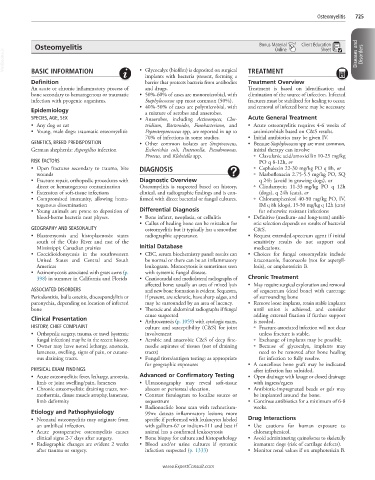Page 1431 - Cote clinical veterinary advisor dogs and cats 4th
P. 1431
Osteomyelitis 725
Osteomyelitis Bonus Material Client Education
Sheet
Online
VetBooks.ir Diseases and Disorders
• Glycocalyx (biofilm) is deposited on surgical
BASIC INFORMATION
implants with bacteria present, forming a TREATMENT
Definition barrier that protects bacteria from antibodies Treatment Overview
An acute or chronic inflammatory process of and drugs. Treatment is based on identification and
bone secondary to hematogenous or traumatic • 50%-60% of cases are monomicrobial, with elimination of the source of infection. Infected
infection with pyogenic organisms. Staphylococcus spp most common (50%). fractures must be stabilized for healing to occur,
• 40%-50% of cases are polymicrobial, with and removal of infected bone may be necessary.
Epidemiology a mixture of aerobes and anaerobes.
SPECIES, AGE, SEX • Anaerobes, including Actinomyces, Clos- Acute General Treatment
• Any dog or cat tridium, Bacteroides, Fusobacterium, and • Acute osteomyelitis requires 4-6 weeks of
• Young, male dogs: traumatic osteomyelitis Peptostreptococcus spp, are reported in up to antimicrobials based on C&S results.
70% of infections in some studies. • Initial antibiotics may be given IV.
GENETICS, BREED PREDISPOSITION • Other common isolates are Streptococcus, • Because Staphylococcus spp are most common,
German shepherds: Aspergillus infection Escherichia coli, Pasteurella, Pseudomonas, initial therapy can involve
Proteus, and Klebsiella spp. ○ Clavulanic acid/amoxicillin 10-25 mg/kg
RISK FACTORS PO q 8-12h, or
• Open fractures secondary to trauma, bite DIAGNOSIS ○ Cephalexin 22-30 mg/kg PO q 8h, or
wounds ○ Marbofloxacin 2.75-5.5 mg/kg PO, SQ
• Fracture repair, orthopedic procedures with Diagnostic Overview q 24h (avoid in growing dogs), or
direct or hematogenous contamination Osteomyelitis is suspected based on history, ○ Clindamycin 11-33 mg/kg PO q 12h
• Extension of soft-tissue infections clinical, and radiographic findings and is con- (dogs), q 24h (cats), or
• Compromised immunity, allowing hema- firmed with direct bacterial or fungal cultures. ○ Chloramphenicol 40-50 mg/kg PO, IV,
togenous dissemination IM q 8h (dogs), 15-50 mg/kg q 12h (cats)
• Young animals are prone to deposition of Differential Diagnosis for otherwise resistant infections
blood-borne bacteria near physes. • Bone infarct, neoplasia, or cellulitis • Definitive (medium- and long-term) antibi-
• Callus of healing bone can be mistaken for otic selection depends on results of bacterial
GEOGRAPHY AND SEASONALITY osteomyelitis but it typically has a smoother C&S.
• Blastomycosis and histoplasmosis: states radiographic appearance. • Request extended-spectrum agent if initial
south of the Ohio River and east of the sensitivity results do not support oral
Mississippi; Canadian prairies Initial Database medications.
• Coccidioidomycosis in the southwestern • CBC, serum biochemistry panel: results can • Choices for fungal osteomyelitis include
United States and Central and South be normal or there can be an inflammatory itraconazole, fluconazole (not for aspergil-
Americas leukogram. Monocytosis is sometimes seen losis), or amphotericin B.
• Actinomycosis associated with grass awns (p. with systemic fungal disease.
398) in summer in California and Florida • Craniocaudal and mediolateral radiographs of Chronic Treatment
affected bone: usually an area of mixed lysis • May require surgical exploration and removal
ASSOCIATED DISORDERS and new bone formation is evident. Sequestra, of sequestrum (dead bone) with curettage
Periodontitis, bulla osteitis, discospondylitis or if present, are sclerotic, have sharp edges, and of surrounding bone
paronychia, depending on location of infected may be surrounded by an area of lucency. • Remove loose implants, retain stable implants
bone • Thoracic and abdominal radiographs if fungal until union is achieved, and consider
cause suspected adding external fixation if further support
Clinical Presentation • Arthrocentesis (p. 1059) with cytologic exam, is needed.
HISTORY, CHIEF COMPLAINT culture and susceptibility (C&S) for joint ○ Fracture-associated infection will not clear
• Orthopedic surgery, trauma, or travel (systemic involvement unless fracture is stable.
fungal infection) may be in the recent history. • Aerobic and anaerobic C&S of deep fine- ○ Exchange of implants may be possible.
• Owner may have noted lethargy, anorexia, needle aspirates of tissues (not of draining ○ Because of glycocalyx, implants may
lameness, swelling, signs of pain, or cutane- tracts) need to be removed after bone healing
ous draining tracts. • Fungal titers/antigen testing: as appropriate for infection to fully resolve.
for geographic exposures • A cancellous bone graft may be indicated
PHYSICAL EXAM FINDINGS after infection has subsided.
• Acute osteomyelitis: fever, lethargy, anorexia, Advanced or Confirmatory Testing • Open drainage with lavage or closed drainage
limb or joint swelling/pain, lameness • Ultrasonography may reveal soft-tissue with ingress/egress
• Chronic osteomyelitis: draining tracts, nor- abscess or periosteal elevation. • Antibiotic-impregnated beads or gels may
mothermia, disuse muscle atrophy, lameness, • Contrast fistulogram to localize source or be implanted around the bone.
limb deformity sequestrum • Continue antibiotics for a minimum of 6-8
• Radionuclide bone scan with technetium- weeks.
Etiology and Pathophysiology 99m: detects inflammatory lesions; more
• Neonatal osteomyelitis may originate from specific if performed with leukocytes labeled Drug Interactions
an umbilical infection. with gallium-67 or indium-111 and best if • Use cautions for human exposure to
• Acute postoperative osteomyelitis causes animal has a confirmed leukocytosis chloramphenicol.
clinical signs 2-7 days after surgery. • Bone biopsy for culture and histopathology • Avoid administering quinolones to skeletally
• Radiographic changes are evident 2 weeks • Blood and/or urine cultures if systemic immature dogs (risk of cartilage defects).
after trauma or surgery. infection suspected (p. 1333) • Monitor renal values if on amphotericin B.
www.ExpertConsult.com

